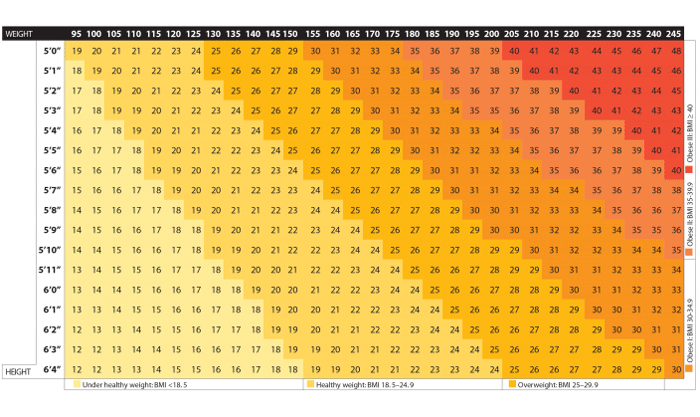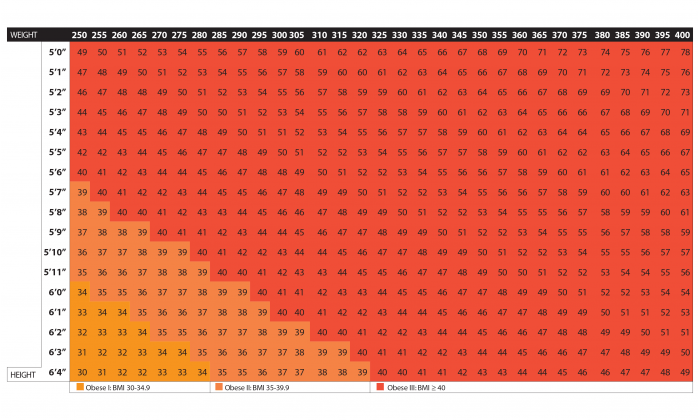Body mass index (BMI) uses a person’s height and weight to help determine if they are a moderate weight. BMI charts also display the ranges for the categories of underweight, overweight, and obesity.
Carrying too much or too little weight can increase a person’s
A person’s BMI is not the only factor that affects this risk. Other tools for assessing whether or not a person has a healthy weight or body composition for them include waist-to-hip ratio, waist-to-height ratio, and body fat percentage.
However, BMI may be a useful starting point. This article provides some tools for people to work out their BMI.
The flaws of BMI
BMI is a calculation of a person’s body fat based on their height and weight. However, studies suggest it is a poor indicator of a person’s body fat percentage.
It can be misleading because the measure does not account for overall body composition. The BMI measurement overlooks bone density, muscle mass, and other considerations.
For additional information, talk with your doctor about other body fat assessment methods.

These calculators and charts can give an indication of whether or not a person’s weight may affect their risk of health problems.
This article publishes the calculators courtesy of The Calculator Site. There are two calculation options available: metric and imperial.
To use the charts below, a person can find their weight in pounds along the top and their height in feet and inches down the side. They can then look across to find their BMI.
There are two charts. If a person’s weight is 245 pounds (lb) or under, they should use the first chart. If their weight is over 250 lb, they should look at the second one.
The shaded areas correspond to BMI values that indicate either a moderate weight, overweight, or obesity.
In addition, researchers and doctors divide obesity into
- Class 1: BMI is 30–34.9.
- Class 2: BMI is 35–39.9.
- Class 3: BMI is 40 and above.
The charts are an adaptation of the adult BMI chart created by the University of Vermont in Burlington.
BMI chart: Weight of 95–245 lb

Adult BMI chart showing ranges “under healthy weight: BMI < 18.5,” “healthy weight: BMI 18.5–24.9,” and “overweight: BMI 25–29.9.”
BMI chart: Weight of 250–400 lb

Adult BMI chart showing ranges “obese 1: BMI 30–34.9,” “obese 2: BMI 35–39.9,” and “obese 3: BMI ≥ 40.”
These figures are only a guide. The BMI tools do not determine whether or not a person has an ideal body weight, but they can help show if an individual’s weight may increase their risk of disease.
A person who is very fit, such as an Olympic athlete, may have a high BMI. However, this does not necessarily mean that they are overweight due to excess body fat. The excess weight, in that case, may be due to increased muscle mass.
The following table shows the standard weight status categories associated with BMI ranges for adults:
| Below 18.5 | Underweight |
| 18.5–24.9 | Healthy |
| 25–29.9 | Overweight |
| 30 and above | Obese |
A BMI of under 18.5 indicates that a person has insufficient weight, so they may need to put on some weight. They should ask a doctor or dietitian for advice.
A BMI of 18.5–24.9 indicates that a person has a healthy weight for their height. By maintaining a healthy weight, they can lower their risk of developing serious health problems.
A BMI of 25–29.9 indicates that a person is slightly overweight. A doctor may advise them to lose some weight for health reasons. They should talk with a doctor or dietitian for advice.
A BMI of over 30 indicates that a person has obesity. Their health may be at risk if they do not lose weight. They should talk with a doctor or dietitian for advice.
Maintaining a moderate weight can help prevent a range of health conditions.
People who are overweight may have a
Having insufficient weight can increase the risk of malnutrition, osteoporosis, anemia, and a range of problems that can result from various nutrient deficiencies. It can also be a symptom of a hormonal, digestive, or other problem.
Some evidence suggests that the associations between BMI, body fat percentage, and body fat distribution may differ across populations due to variations in sex, race, and ethnicity.
A
They concluded that to predict obesity-type body fat percentage, the standard BMI threshold of 29.9 kilograms per square meter (kg/m2) was appropriate for males but that a more suitable cutoff point for females appeared to be 24.9 kg/m2.
In 2017,
In Korea, they added, there is evidence to suggest that almost twice as many people have features of metabolic obesity but a moderate weight compared with the United States.
The results of one
The following table by the WHO shows some comparisons and cutoff points that may apply. Doctors may use these variations when advising or treating conditions in specific people.
| Underweight | < 18.50 | < 18.50 |
| Severe thinness | < 16 | < 16 |
| Moderate thinness | 16–16.99 | 16–16.99 |
| Mild thinness | 17–18.49 | 17–18.49 |
| Normal range | 18.5–24.99 | 18.5–22.99 23–24.99 |
| Overweight | ≥ 25 | ≥ 25 |
| Pre-obese | 25–29.99 | 25–27.49 27.5–29.99 |
| Obese | ≥ 30 | ≥ 30 |
| Obese class 1 | 30–34.99 | 30–32.49 32.5–34.99 |
| Obese class 2 | 35–39.99 | 35–37.49 37.5–39.99 |
| Obese class 3 | ≥ 40 | ≥ 40 |
Weight management resources
To discover more evidence-based information and resources for weight management, visit our dedicated hub.
BMI is a useful tool that gives a general idea about whether or not a person’s weight is healthy for them.
However, it is a simple tool that does not tell the whole story about people’s individual weight and health risks.
Anyone who is concerned about their weight should speak with a doctor, who may also consider their body fat distribution and the ratio of their waist size to their height. The doctor will also be able to offer advice to suit every individual.
